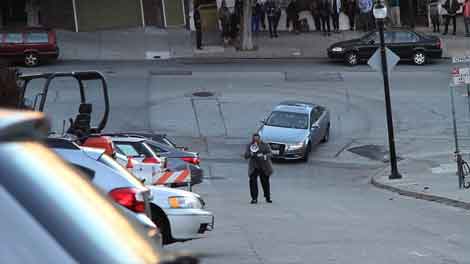In retrospect, Machine Project—the Echo Park storefront operating for the last decade as a rapid-fire curatorial clearinghouse for founder/director Mark Allen’s tireless curiosity—would seem to have been one of the most influential artistic endeavors of the new millennium. Bridging the faux-institutional critique of the Museum of Jurassic Technology and Center for Land Use Interpretation with the collaborative rhizomatics of Generation Occupy, MP has been both a model for a host of subsequent networking nodes, and one of the busiest neural clusters in the increasingly web-like cultural underground.
But for all its nonprofit camouflage and programmatic eclecticism, MP very much retains the profile of an idiosyncratic artwork bearing the signature of an individual curatorial author. This is the link back to the MJT and CLUI—and even further: think of Jonas Mekas’ Anthology Film Archives. But where Mark Allen splits forward is with the ostentatiously exhaustive range of phenomena that take refuge under the Machine umbrella. Robotics, kimchee-making, avant-garde theater, permacuture, fractal models constructed from business cards, flower volcanoes, deep-frying parties, nude readings of conquistador reports punctuated by weeping fits and the eating of fancy ham—you name it!
Machine Project ends up being like the coolest magazine ever—reconfigured as an immersive, interactive, constantly changing environment. Which may not be mere happenstance, since Allen started out as a zinester back in the day, with a Houston-based DIY publication called SCAM. Much of the mutual aid bohemianism, “prosthetic enthusiasm,” and counter-institutional thinking for which Machine functions as a nexus is directly traceable to the pre-digital slackerism of the zine era.
Machine’s latest project is essentially a video zine documenting a representative sampling of typical MP happenings from 2010–12. These range from an opera starring dogs to a guy singing “I Left My Heart in San Francisco” through a megaphone while climbing a hill in San Francisco; from a relational aesthetics museum residency for houseplants to a drag tableaux-vivant reenactment of scenes from the Marlene Dietrich western Destry Rides Again; from the perverse harnessing of the kinetics of an aerobics workout to churn butter to a workshop on how to escape from the trunk of a car “so that the next time you’re kidnapped it doesn’t have to ruin the rest of your day.”
Directed by Allen and produced, shot and edited by Emily Lacy, Machine Project Selected Films 2000-2012 is highly entertaining in its own right, and a more-than-adequate précis of a curatorial vision that doesn’t lend itself to reductive translation. Personally, I would have liked to see less of the poetry readings and more of the how-exactly-is-it-you-get-out of-that-car-trunk. But I guess if it makes me want to get off my ass and participate in more of Machine Project’s uncategorizable offerings, it’s probably achieved its aims.
An equal but opposite dummy institution is the Boston Visionary Cell, though I’m not sure it ever involved anyone but founding artist Paul Laffoley. Which is fine, because the guy could probably fill two dummy institutions. Since the late ’60s, Laffoley’s information-dense paintings have successfully straddled hermetic mysticism, paranormal phenomena (including alien contact), fringe physics, and utopic architecture and engineering, not to mention some badass graphic design. Articulating an ornately modernist didacticism—while predicated on a radically reimagined psycho-spiritual function for art—his exquisite charts defy easy assimilation by the mainstream art world, as well as the lowbrow and outsider.
When I first encountered Laffoley’s work, I wasn’t clear about his sincerity—could this be merely an elaborate but superficial appropriation of the vocabulary of expanded consciousness and paranoid conspiracy cognition? The newly published Premonitions of the Bauharoque dispels any such concerns, delivering a mother lode of Laffoley’s writings dating back to 1972. Though tagged as “Journals” the bulk of the volume consists of three facsimiles of hand-scrawled manuscripts: “Principles of Alchemy,” a 93-page treatise on the ancient system of symbol manipulation; “Visions of History,” which seeks “to determine the extent to which the philosophic category of meta-history or the philosophy of history can converge with the various historical or contemporary art-forms”; and “The Bauharoque,” Laffoley’s sprawling 1989 anti-Postmodernist manifesto, part memoir, part revisionist art history, part call-to-arms.
Quite apart from their value to Laffoley fans and scholars in fleshing out the sometimes cryptic philosophical concepts diagrammed in his visual work, the texts themselves are phenomenal examples of the kind of audacious free-range intellectual inquiry that can usually only be found in the kind of self-published mail-order treatises these “journals” resemble. I have to confess I haven’t quite put it all together yet, but I enjoy trying. And when I finally do, Laffoley seems to promise, it will be a shining and joyous cosmos beyond the end of time. Now, I may not know Art, but I know what I like.
Paul Laffoley: Premonitions of the Bauharoque
Henry Art Gallery,
University of Washington, 2013
ISBN: 978-0-935558-52-4
Machine Project Selected Films 2000-2012 AKA Machine Project’s Greatest Hits
DVD available from
store.machineproject.com


